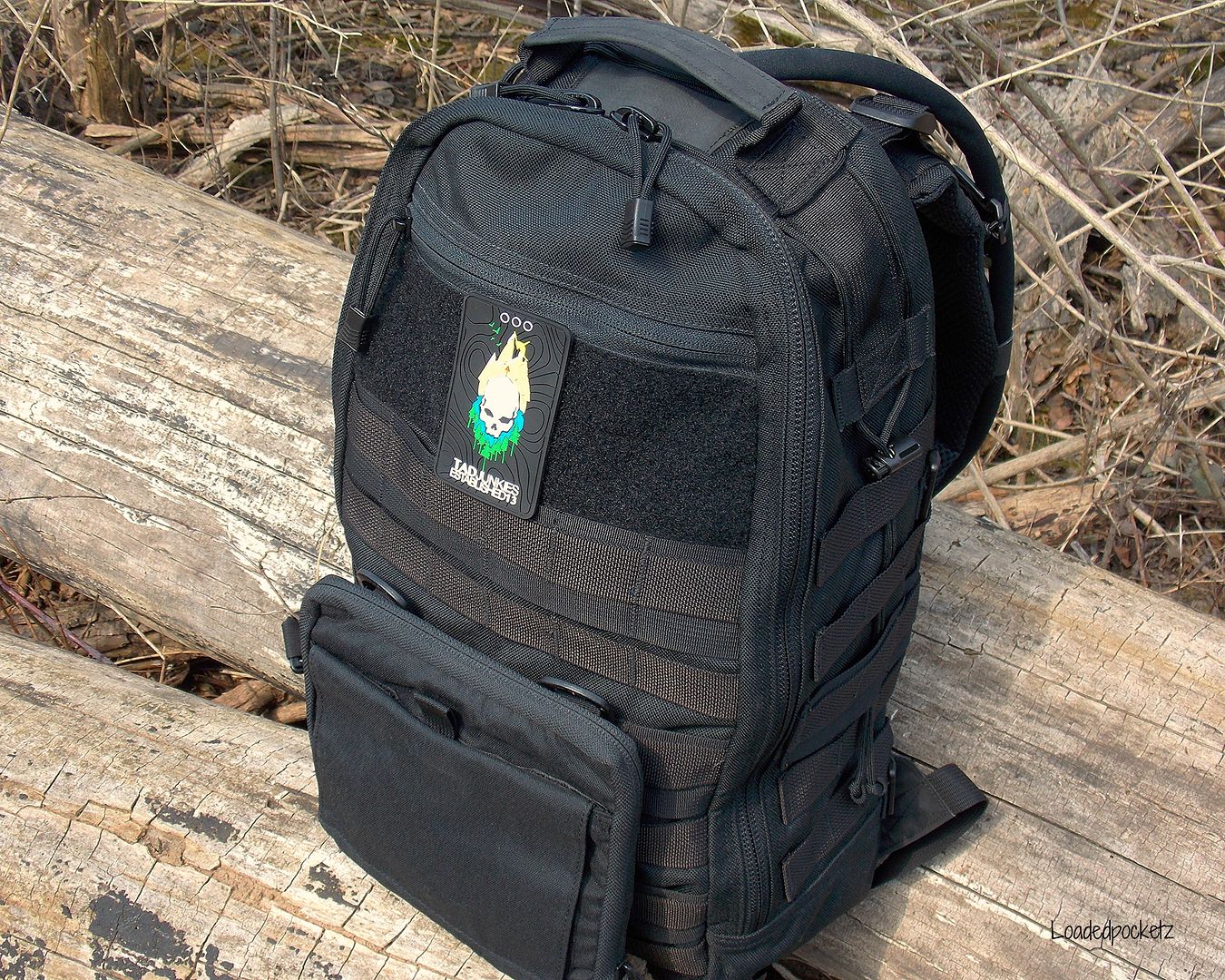Triple Aught Design released a re-engineered version of their popular Fast Pack Litespeed this past October.

The new Triple Aught Design Fast Pack Litespeed
Since then, it’s been restocked and sold out several times. How does the new version measure up? TAD was kind enough to send the new pack our way to evaluate and I’ve spent a good chunk of the winter carrying it and making notes trying to answer that very question.
The Triple Aught Design Fast Pack Litespeed is a designed as a 24-hour pack that can be tailored to meet different carry needs. I’ve used it in both wilderness and urban environments and it adapts well to both with certain limitations (more on that later).
This time of year, hiking is a bit of a grind here in the Midwest. The weather can change rapidly, the ground is usually wet and muddy, and the cool wind can cut right through you. Even when I’m going it alone, I do sometimes share the trail with others who tend to notice the gear I carry and ask about it. Especially when I carry something new.

Dude, is that the new Triple Aught Design Litespeed?
The Litespeed measures 10.00″ W x 20.00″ H x 6.75″ D with a volume of 1,350 cubic inches. In response to feedback that the previous gen pack was too long, TAD shorted the Litespeed by 2.0 inches and increased its depth by 1.75″. The reshaped pack is a little chunkier when packed to near capacity…

But it’s still long enough for my 6’4″ frame.

Overall, I believe the change will prove to be a positive one since folks who are more “vertically challenged” will be able to achieve a better fit with this pack.
Another significant upgrade was the attention paid to the back panel and straps. A non-removable HDPE sheet was sewn in to improve frame rigidity. New thicker foam and moisture wicking mesh was added and the straps were redesigned to fall straight and not curve inward, making them more comfortable for broader shoulders.

Despite it’s size, the Litespeed isn’t a light pack at 3.8 lbs. In comparison, the Camelbak Mil Tac HAWG has 50 cubic inches more capacity and weighs a pound less. The weight of all that 500D/1000D Cordura nylon, MOLLE webbing, milspec straps, and other hardware adds up fast. However, the extra back panel padding, frame sheet, and beefier straps keep that from becoming an issue and overall I’ve found the Litespeed to be comfortable (even when loaded up with gear).
I wasn’t as impressed with the lack of hydration tube routing options on the new straps, but TAD includes quite a few ITW Web Dominators with the pack and I used a couple of them to keep the tube in place in lieu of a built-in option.

There was much fanfare over the inclusion of the Web Dominators and elastic bands (like shown above on the sternum strap) that help keep the excess webbing under control on the Litespeed. I get it and the new model is MUCH cleaner than the untamed strap orgy that was the earlier version. However, I consider strap management to be table stakes for packs in this price range. I’m glad TAD listened to their customers by improving that aspect of the Litespeed and that deserves praise, but let’s not sugarcoat it. It isn’t exactly an innovation.
Speaking of listening to customers, the load lifter buckles are gone in this version. The straps are attached directly to the pack. No more annoying buckles to un-clip to get into the main compartment. It’s a better design and alone may be worth an upgrade for those who already have a previous gen model.
The carry handle and hydration port are reinforced with Hypalon, which is a synthetic rubber. Zippers, as one would expect, are YKK with genuine 550 paracord pulls.

Also new is a lightweight attachment system along the handle that uses 96 inches of paracord and is supposed to provide “an easy way to attach bulky items such as a rope or jacket to the top of your pack for easy access”.

Well, I can report that I haven’t used it once and I’m not sure why you’d want to lash something bulky like a jacket to the top like that. Having an extra 96 inches of removable paracord for emergency use not taking up space on the inside of the pack is a good thing, but I’m not sold on it as a way to lash stuff to the outside of the pack. Especially on one as small as the Litespeed. Your mileage may vary.
Both sides of the bag are covered in MOLLE webbing. TAD sells a variety of MOLLE compatible pouches that can be attached there to keep things within reach and to save internal space for more gear. As with the packs, availability of the pouches can be an issue. That said, the S1 and S2 sheaths are very popular Litespeed accessories and most Litespeed owners try to stock up when they do drop.

Note (in the picture above) the two buckles that can be used to attach the included MOLLE Transporter Tail to the outside of the pack. I’ve yet to use it like that because I moved the Transporter Tail to the main compartment.

Why? Because TAD removed the internal sleeve from the Litespeed to make room for anchor points that can be used to attach accessories like the Transporter Tail to the inside of the pack. Carryology, in their first look preview, provided a sneak peek at some other add-ons that TAD plans to offer like a second sterile transporter tail and a MOLLE panel. The problem is, at the time of this writing and five months after launch, they haven’t made them available.
So, if you want to secure something like a hydration bladder, laptop, or tablet inside the main compartment, the only option is the included MOLLE transporter tail. I’d characterize that as a step backward compared to the previous model until the new accessories are available and even then I could make a strong argument that the second sterile tail should have been included with purchase. Especially given TAD’s stocking issues. Some Litespeed owners may not be able to get their hands on one for quite some time.
I wish they would have followed the K.I.S.S. principle by scraping the whole thing by keeping the external tail and just going with a built-in padded sleeve which would have been more laptop and tablet friendly for urban use. But maybe that’s just me.
The webbing on the top buckle replaces the clip on the earlier model. It can be used to suspend both Source and Camelbak branded hydration systems. Here I’m using the Camelbak Milspec Antidote.

The main compartment on the Litespeed is spacious with the added depth. On this day, I carried my Arc’teryx Atom LT as an insulating mid-layer for the Stealth LT, a TAD Shemagh, Slick Mini II Tripod, and a Lowepro Camera Case with room to spare.

I didn’t snap a picture of them but the location of the two mesh zippered pockets on the inside of the main compartment front flap hasn’t changed. I used the bottom one to store my FAK and the top for food.
Which brings me to the zippered admin pocket on the outside of the flap. It seems a little easier to get into and reportedly TAD made the pen loops bigger to accommodate tactical size pens.

Despite the changes, for me, the design of the Litespeed’s admin pocket has always left something to be desired and they didn’t improve it enough in this version to change my mind. If you believe in conspiracy theories, you’d say it’s tailor-made to sell more OP-1 admin pouches. Well, it’s certainly easier to get to your stuff when it laid open like this compared to the picture above.

Below the admin pocket is a generous loop field that can be used to attach name tapes and morale patches like this nice one from TADJunkies.

The bottom of the Litespeed has more MOLLE and adjustable straps with web dominators to lash a sleeping mat or other gear.

CONCLUSION
Overall, the new Litespeed is enough of an improvement for TAD enthusiasts to justify an upgrade over the previous model. TAD is making the decision more difficult for some by not including the second Transporter Tail with the pack and (at the time of this writing) not making it available for sale as an accessory, but the elimination of the load lifter buckles, improved strap management, and other added features make this version much more user-friendly.
For others who are considering a Triple Aught Design backpack for the first time, the Litespeed offers a lot of versatility in a rugged package that’s tailor-made for minimalist carry. As was the case with the larger Fast Pack EDC that we reviewed back in 2013, the build quality with the Litespeed is what you’d expect from a premium manufacturer and it should weather just about any abuse you throw at it.
The Triple Aught Design Fast Pack Litespeed retails for $245 and is available for sale from Triple Aught Design’s website, retail store locations, and select dealers. It’s only available in black and is currently out of stock, but TAD does replenish their supply often and more colors like Coyote Khaki and Foliage Green should be added in the future. Sign up for TAD’s Newsletter and/or check their Facebook page for updates on availability.
The post Triple Aught Design Fast Pack Litespeed Review appeared first on Loaded Pocketz.